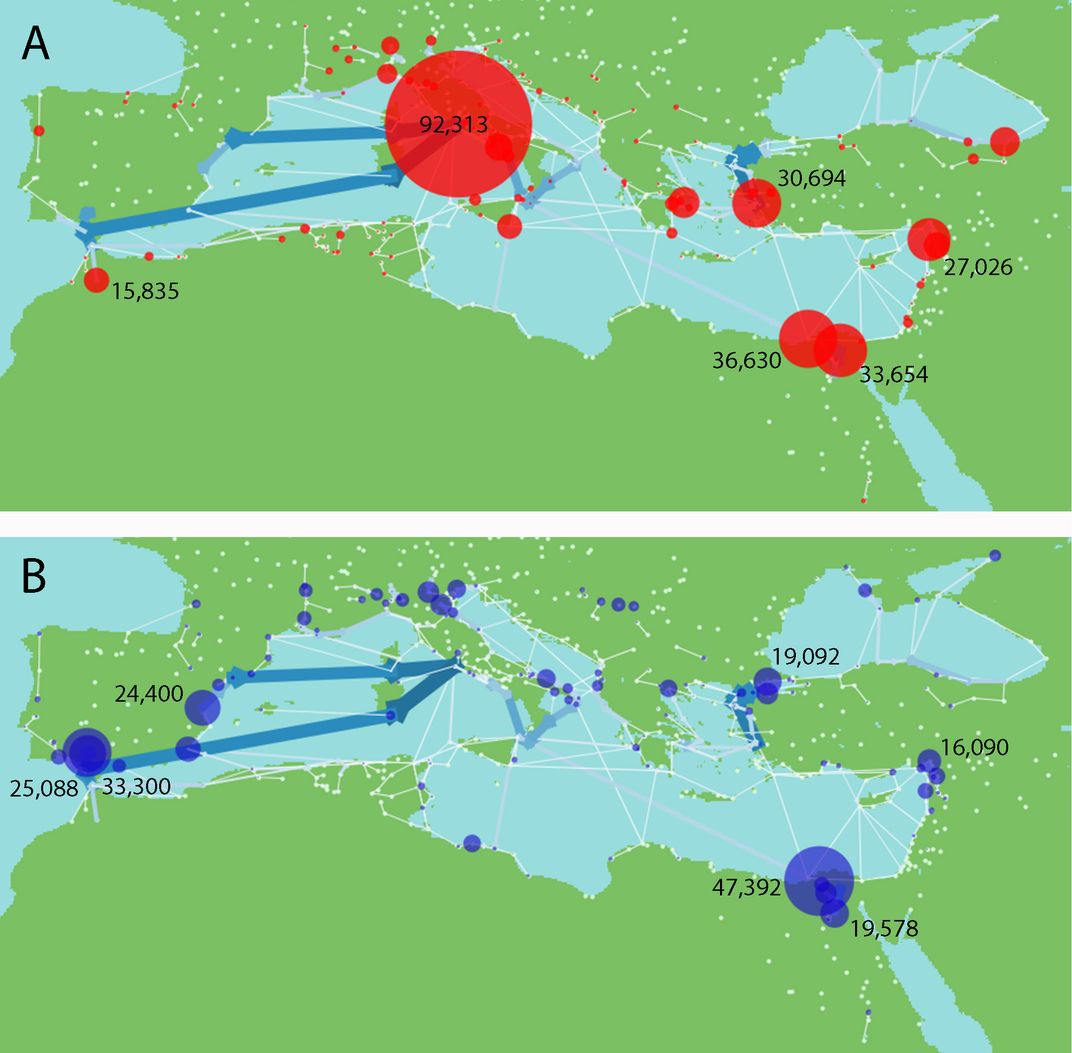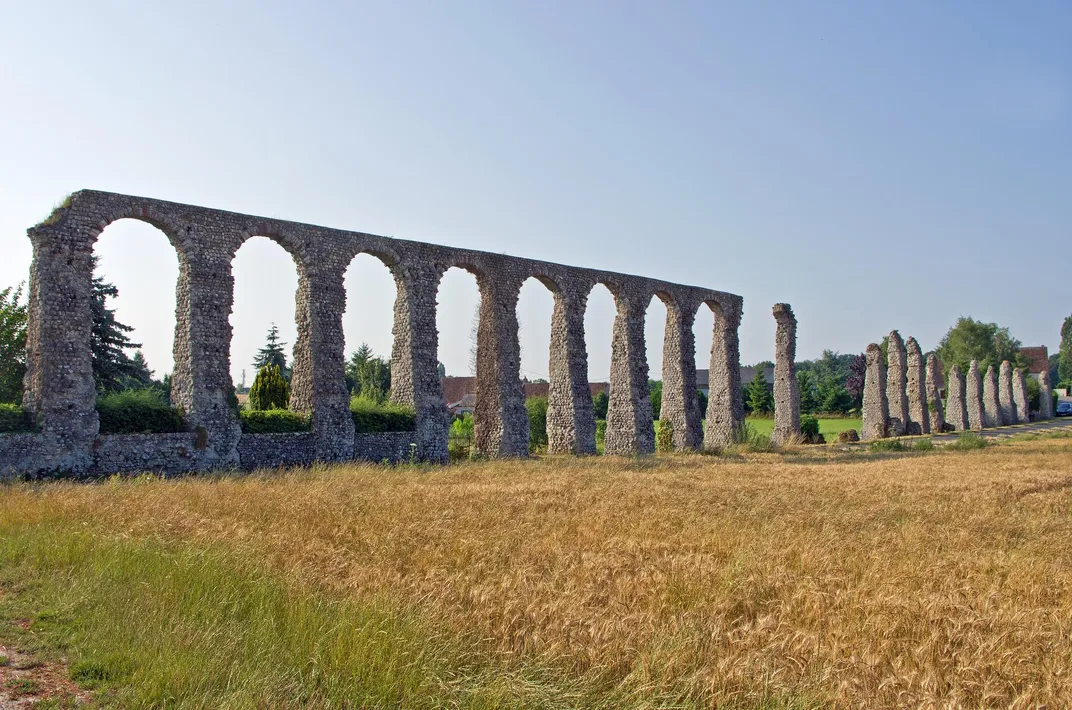Ancient Roman Water Networks Made the Empire Vulnerable
A model of ancient water movement shows how trade practices might affect today’s urban centers as the climate changes
/https://tf-cmsv2-smithsonianmag-media.s3.amazonaws.com/filer/ad/03/ad0386a9-da96-4134-9abf-e42d9af795fe/42-49217434.jpg)
Ancient Romans were masters of water manipulation. They moved fresh water around their vast empire with aqueducts and canals. Farmers shipped their wares across the seas to big cities such as Alexandria, Memphis and Rome. Trade routes allowed people to live on dry and infertile land, fed by grain from more productive regions—shades of Southern California. Now a model of water and grain trade in the Roman Empire offers an intriguing tool for predicting what may happen to modern cities as Earth's climate changes.
"There are many parallels between the Roman Empire and the current situation," says lead researcher Brian Dermody, an environmental scientist at Utrecht University in the Netherlands. "We're very interested to know how society is going to deal with pressures related to climate change and population growth."
Predicting what people will do in the future is difficult, however, so Dermody and his colleagues turned to the easier task of writing a model for a past society. The Roman Empire offered an appealing test case, because at its peak around 100 A.D., it supported about 50 million people spanning multiple continents. From there, the team could alter conditions and see what happened. What if a region becomes more urbanized? What if the climate shifts?
Ancient Rome isn't a perfect mirror for the modern world because trade and communication are so much more sophisticated now. But Dermody hopes his model could serve as a base for those who model countries' responses to climate change. "You can add complexity on top of our model," he says.

The work is based on a concept that researchers came up with to describe trade in the 1990s: virtual water. When cities and countries trade certain products, they're actually trading water. The concept works especially well for food trade. After all, estimates say that anywhere from 70 percent to more than 90 percent of the fresh water humanity uses goes toward agriculture. Thinking of trade in terms of virtual water helps researchers track how countries manage the resource.
Dermody's team began by tracing actual water in ancient Rome, using a hydrological model to predict how much grain different regions produced. After that, however, the team tracked everything in terms of the virtual water the grain represented as it was bought, sold and shipped between cities. The team published the work this month in the journal Hydrology and Earth System Sciences.
"It's interesting to see the concept being applied to the old world," says Arjen Hoekstra, a water-management researcher at the University of Twente in the Netherlands. Hoekstra pioneered the idea of "water footprints," which are analogous to carbon footprints. "Classic Rome externalized its land and water footprint to far outside its own regional boundaries, just like Europe does today," he says. "This pattern is true for every city or large density of people, and I think it's true for many civilizations."
The results could serve as a warning to modern civilization. In ancient Rome, trade routes kept everyone supplied with food and water. The more trade routes a city maintained, the better insulated it was against droughts, because it could import from unaffected regions. At the same time, more food coming in through trade encouraged cities' populations to grow, increasing their dependence on imports and making them more vulnerable to reduced crop yields or shaky trade agreements.
"As urbanization increases, cities become more dependent on these trade networks," says Dermody. "So not only are you susceptible to changes in crops, you're also susceptible to maybe breakdown in the trade." These perils of urban growth in ancient Rome have parallels in the modern world. People are now moving to cities at an unprecedented rate, and all large cities depend on receiving food from somewhere else. A dense city usually can't grow enough to feed itself, even with the efforts of urban farming enthusiasts. "This is probably one of the main reasons that large cities developed primarily along the coast or on large rivers, where bulk food goods could be brought in by ship," Dermody says.

That's not to say modern-day nations will fall exactly the same way as the Roman Empire. Historians generally agree that the empire declined primarily because of a combination of political reasons, not resource-based ones. Also, while it suffered droughts, the Roman Empire didn't deal with anything as extreme as the anthropogenic climate change of today.
In addition, Dermody's model of Roman trade is much simpler than the rules that govern global trade today. The Roman government regulated grain trade under strict rules, considering it too important to be left to the free market. Dermody's model calculates what that grain trade would have been like, assuming everyone worked logically to move food from water- and agriculture-rich areas to areas with less water and farmland. Modern governments, on the other hand, make "illogical" trades all the time to serve political ends.
While Dermody's model can show how trade helped ancient Romans deal with droughts, it's unclear how trade will affect modern cities facing the extreme weather events that come with global warming. "Some people think trade makes you more resilient, and some people think trade makes you less resilient," says Megan Konar, an environmental engineer who studies water and food trade at the University of Illinois at Urbana-Champaign. "That's still a question people are working on."
Nevertheless, Konar found the Roman model interesting because it offered a way to link two competing schools of thought about the effect of trade on climate change resilience. "The findings basically say that having a lot of trade, in the short term, makes you more resilient to climate impacts, but in the long term, you're more sensitive," she says. "Their model can capture these two mechanisms. Both schools of thought could be correct at the same time."
/https://tf-cmsv2-smithsonianmag-media.s3.amazonaws.com/accounts/headshot/fcdiep_headshot_480x480.png)
/https://tf-cmsv2-smithsonianmag-media.s3.amazonaws.com/accounts/headshot/fcdiep_headshot_480x480.png)